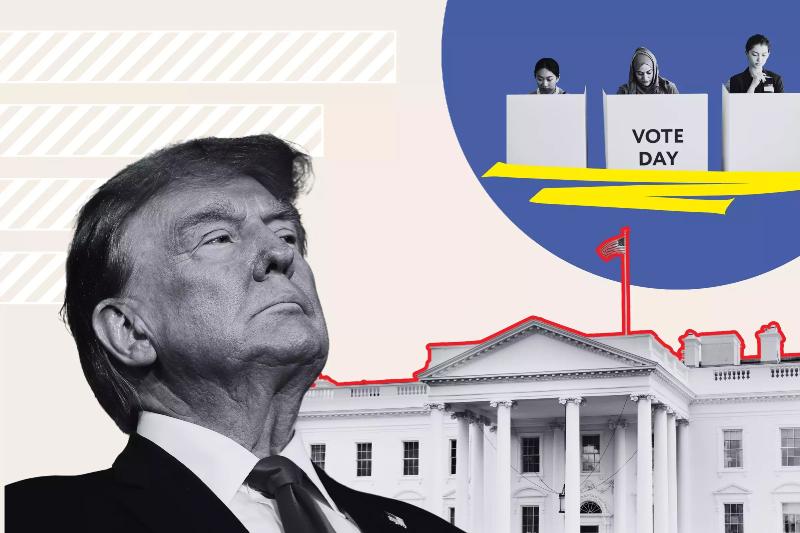Donald Trump's Big Election Problem—'Likely Voters'



By Ewan Palmer News ReporterFOLLOW
Donald Trump's hopes of winning the 2024 Election may be hindered by a lack of his supporters heading to the ballots, polls have suggested.
There have been a number of examples in recent surveys which note that while the presumed GOP presidential candidate in November is ahead of Joe Biden in a general poll of U.S. adults or registered voters, the current president beats Trump when the data is broken down to likely voters.
The results indicate that Biden—who has long faced concern about his polling numbers, approval ratings, age, and cognitive ability—may have additional ammunition against Trump as he looks to defeat the Republican in an election for the second time in a row.
Newsweek reached out to Trump's campaign team by email for comment.
A Big Village poll released in January showed that the presumptive 2024 Election between Biden and Trump is neck and neck, with both candidates receiving 38 percent among registered voters. Yet among those who said they are likely voters, Biden takes the lead (42 to 39 percent).
Polls suggest that Donald Trump has an issue with "likely" voters heading into the 2024 Election.Polls suggest that Donald Trump has an issue with "likely" voters heading into the 2024 Election.Photo-illustration by Newsweek/Getty
A month earlier, a New York Times/Siena poll found that Trump leads Biden by 46 percent to 44 percent among registered voters. However, when the results are broken down to just those who said that they are "almost certain" or "very likely" to cast a ballot in the 2024 Election, the results switch and Biden beats Trump by 47 percent to 45 percent.
Also in December, a Reuters/Ipsos poll found Trump with a 2-point lead in a head-to-head matchup with Biden (38 percent to 36) in a survey of 4,411 U.S. adults nationwide.
The results improve for Biden again when the results are just between likely voters. In this case, the poll found that in the seven states where the election was closest in 2020—Arizona, Georgia, Michigan, Nevada, North Carolina, Pennsylvania and Wisconsin—Biden had a 4-point lead over Trump among Americans who said they were sure to vote.
Biden won all these states except North Carolina in 2020, and would need to ensure he holds on to most of them while winning strong Blue states if he has any hopes of a second term.
Cary Coglianese, an Edward B. Shils professor of law at the University of Pennsylvania Carey Law School, suggested that the reason for the change of outcomes is that general polls feature members of the public who are "expressing more of their feeling" about the state of affairs, such as the economy, in comparison with voters who intend to go to the ballot box.
"As the election gets closer, people are likely to focus more on what it would really be like to have another four years of President Biden versus President Trump," Coglianese told Newsweek. "The Biden team is hoping to fare well with that comparison."
As with any poll result, there are a number of caveats that need to be considered.
The 2024 election is still nine months away, meaning there is plenty of time for other outcomes to influence who voters will back. Trump is facing 91 felony charges, to which he has pleaded not guilty, across four criminal trials, with Biden continuing to be met with concerns about his age and his handling of the Israel-Hamas conflict.
There are also still a significant number of surveys which show Trump is the current frontrunner in the close race, including those which only feature likely voters.
Christopher Borick, a professor of political science and director of the Muhlenberg College Institute of Public Opinion, said that the rise of Trumpism has buoyed Democratic voters to come out and vote for the past eight years, which has helped "propel" Democrats to multiple victories in midterm and off-year elections.
"While this is good news for Democrats in lower-turnout elections, the impact on the presidential race is less clear," Borick told Newsweek.
"The most likely voters do lean towards Biden, and if the overall turnout this fall declines from 2020, a possibility given dissatisfaction with the alternatives, Biden may have a slight advantage.
"However, the lack of enthusiasm for Biden combined with Trump's demonstrated ability to bring out less regular voters—such as lower educated and working-class voters—may negate the slight advantage Biden has in polls that give higher weights to traditional likely voters," Borick added.
Coglianese also noted that even though Trump can easily rely on his strong MAGA base to support him at the ballots, this may not be enough to secure a general election victory.
"Voters concerned about reproductive rights and the future of democracy and the rule of law will likely be highly motivated to get out to vote—and there may be enough of them to put Biden on top," Coglianese said.

Tags








